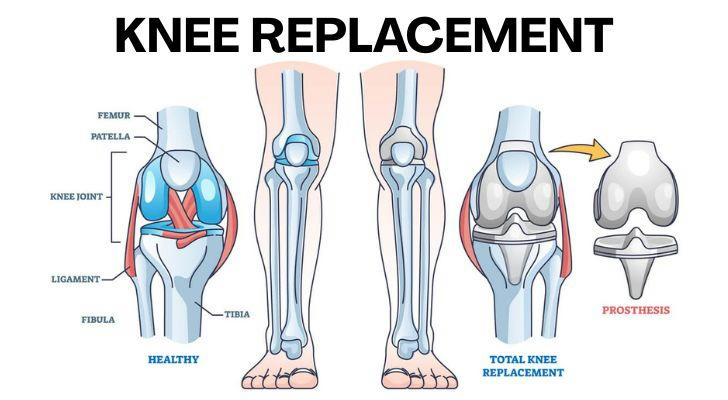Knee Replacement Surgery & Recovery: What Every Patient Needs to Know
Knee replacement surgery can be a life-changing procedure that helps alleviate chronic knee pain and restores mobility. Here's a closer look at what to expect, from the surgery itself to the rehabilitation following total knee replacement.

Why Consider Knee Replacement Surgery?
Chronic knee pain can significantly impact your quality of life, making everyday activities challenging. When medications and physical therapy no longer provide adequate pain relief, knee replacement surgery might be a viable option. It involves replacing damaged parts of the knee joint with artificial components, allowing for improved function and reduced discomfort. This surgery is not just for the elderly; it can benefit anyone experiencing severe knee issues that hinder their daily activities.
There are different types of knee replacement surgeries available, including total knee replacement and partial knee replacement. Total knee replacement is suitable for those with extensive damage, while partial knee replacement is an option when only a portion of the knee is affected. Robotic knee replacement is a newer technique that offers precision and can lead to a quicker recovery, thanks to its minimally invasive approach.
The Surgery Process
Knee replacement surgery typically takes a few hours and is performed under anesthesia. During the procedure, the surgeon removes damaged cartilage and bone, replacing them with metal and plastic components. This creates a new, smooth joint surface that significantly reduces knee pain and enhances mobility. Advances in technology, like robotic knee replacement, have improved the accuracy of these procedures, leading to better outcomes and shorter hospital stays.
Post-surgery, you'll spend a few days in the hospital where your recovery will be closely monitored. Healthcare professionals will help manage pain relief and ensure you begin moving your knee as soon as possible. Early movement is crucial to prevent stiffness and promote circulation, which aids in the healing process. The initial phase of recovery focuses on managing pain and starting gentle movements to lay the groundwork for successful rehabilitation.
Recovery and Rehabilitation
Rehabilitation following total knee replacement is essential for a successful recovery. Physical therapy plays a critical role, helping you regain strength and mobility. A tailored exercise program will be developed to suit your needs, gradually increasing in intensity as your knee heals. These exercises will not only improve joint function but also boost your confidence in using your new knee.
While the timeline for recovery varies, most people can return to normal activities within a few months. Adherence to the rehabilitation plan is key to achieving the best results. You'll work closely with physical therapists to ensure your recovery is on track, focusing on exercises that enhance flexibility and strength. Consistent effort in physical therapy sessions will expedite your recovery and help you return to the activities you love.
Benefits of Knee Replacement Surgery
Undergoing knee replacement surgery can dramatically improve your quality of life. One of the most immediate benefits is significant pain relief, which allows you to engage in activities that were previously too painful. As your mobility improves, you'll notice increased independence and the ability to participate in social and recreational activities that you enjoy.
In addition to physical benefits, knee replacement surgery can positively impact your mental well-being. The reduction in chronic pain often leads to better sleep, improved mood, and a more active lifestyle. Over time, you'll find that the surgery not only restores your physical abilities but also enhances your overall outlook on life.
Common Myths—Busted
Let’s set the record straight:
•Myth 1: “I’ll never bend my knee normally again.”
Truth: Modern implants allow for near-normal range of motion (most patients regain 110-120 degrees of flexion, enough for stairs, cycling, or even dancing).
•Myth 2: “Recovery is too hard—I’ll need help forever.”
Truth: While you’ll need physical therapy for 3-6 months, most patients regain independence quickly. Linda’s husband helped for the first month, but she was managing on her own by week 6.
•Myth 3: “The implant will wear out in 5 years.”
Truth: High-quality implants last 15-20 years in most patients. A 2021 study in JAMA Network Open tracked 100,000 TKA patients and found a 98% survival rate at 10 years.
Long-Term Outlook
With advancements in surgical techniques and materials, the long-term outlook for knee replacement patients is promising. Most replaced knees can last for decades, especially with proper care and regular follow-ups with your healthcare provider. Maintaining a healthy weight and staying active are crucial for the longevity of your new knee joint.
It's important to stay informed about your health and any developments in the field of knee replacement. Regular check-ups with your orthopedic surgeon will ensure any potential issues are addressed promptly. With ongoing care and attention, you can enjoy the benefits of knee replacement surgery for many years, leading a life free from the constraints of chronic knee pain.
